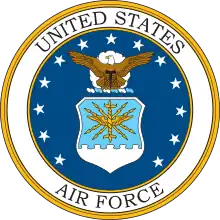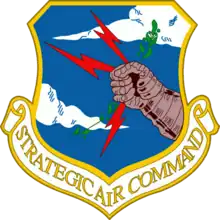| 487th Bombardment Squadron | |
|---|---|
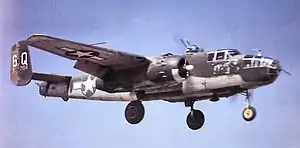 Squadron B-25 Mitchell on landing approach to Alesan Airfield[note 1] | |
| Active | 1942–1945; 1947–1949; 1952–1963 |
| Country | |
| Branch | |
| Role | Medium bomber |
| Engagements | Mediterranean Theater of Operations[1] |
| Decorations | Distinguished Unit Citation[1] |
| Insignia | |
| 487th Bombardment Squadron emblem[note 2] | 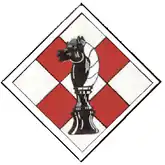 |
| 487th Bombardment Squadron emblem (World War II)[2] | 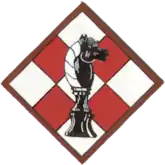 |
The 487th Bombardment Squadron is an inactive United States Air Force unit. It was last assigned to the 340th Bombardment Wing at Whiteman Air Force Base, Missouri, where it was inactivated on 1 September 1963. The squadron was first activated during World War II. After training in the United States, it deployed to the Mediterranean Theater of Operations, where it flew North American B-25 Mitchell medium bombers, primarily on air support and air interdiction missions, earning two Distinguished Unit Citations for its actions. After V-E Day, the squadron returned to the United States, where it was inactivated in November 1945.
The group was again active in the reserve from 1947 to 1949, but does not appear to have been fully manned or equipped with operational aircraft during this period. It was again activated in October 1952, as the Air Force reopened Whiteman Air Force Base, Missouri. It flew Boeing B-47 Stratojets at Whiteman until September 1963, as the B-47 began to be withdrawn from Strategic Air Command operations. It was inactivated with the withdrawal of its Stratojets.
History
World War II
Established as a North American B-25 Mitchell medium bomber squadron in mid-1942, trained by Third Air Force in the southeastern United States. Deployed to IX Bomber Command in Egypt initially in March 1943 via the South Atlantic Route through the Caribbean, Brazil, Liberia, Central Africa and Sudan, then reassigned to XII Bomber Command in Tunisia. Supported Allied ground forces in Tunisian Campaign; participated in Invasions of Sicily and Italy during 1943, supporting Allied ground forces with tactical bombing of enemy targets. Participated in liberation of Corsica during the spring of 1944, then returned to Italy engaging in attacks on enemy ground forces and targets in the Po Valley during the spring of 1945.
Personnel demobilized in Italy during summer of 1945; squadron returned to the United States, being prepared for deployment to Pacific Theater for use as a tactical bomb squadron in programmed Invasion of Japan. Japanese capitulation led to squadron's inactivation in November 1945.
Air Force reserve operations
Activated in the postwar Air Force reserves in 1947; inactivated in 1949 due to budget reductions.
Strategic Air Command operations
Reactivated in October 1952 as a Strategic Air Command (SAC) Boeing B-47 Stratojet squadron. Initially equipped with prototypes of the Boeing RB-47B Stratojet (YRB-47) to perform long-range photo-reconnaissance with a flight of Boeing B-29 Superfortress bombers assigned. In November 1953 began to receive production B-47E medium bomber aircraft; prototype reconnaissance aircraft already received exchanged for medium bomber versions. Participated in SAC Operation Reflex deployments to Europe and North Africa throughout the 1950s and 1960s.
In 1963 with the phaseout of the B-47 the aircraft sent to storage at Davis–Monthan Air Force Base, Arizona and the squadron was inactivated.
Lineage
- Constituted as the 487th Bombardment Squadron (Medium) on 10 August 1942
- Activated on 20 August 1942
- Redesignated 487th Bombardment Squadron, Medium 20 August 1943[3]
- Inactivated on 7 November 1945
- Redesignated 487th Bombardment Squadron, Light on 8 October 1947
- Activated in the reserve on 31 October 1947
- Inactivated on 19 August 1949
- Redesignated 487th Bombardment Squadron, Medium on 3 October 1952
Assignments
- 340th Bombardment Group, 20 August 1942 – 7 November 1945[1]
- 340th Bombardment Group, 31 October 1947 – 19 August 1949[1]
- 340th Bombardment Wing, 20 October 1952 – 1 September 1963[6]
Stations
|
|
Aircraft
- North American B-25 Mitchell, 1942–1945
- Boeing YRB-47 Stratojet, 1954–1955
- Boeing B-47 Stratojet, 1955–1963[1]
References
Notes
- Explanatory notes
- Citations
- 1 2 3 4 5 Maurer, Combat Squadrons, p. 585
- ↑ Watkins, pp. 87-88
- ↑ See Haulman, Daniel (1 November 2016). "Factsheet 340 Flying Training Group (AFRC)". Air Force Historical Research Agency. Retrieved 13 February 2021. (redesignation of 340th Group).
- ↑ Lineage information through May 1963 in Maurer, Combat Squadrons, p. 585, except as noted
- ↑ See Ravenstein, p. 179 (end of assignment to 340th Wing); Mueller, p. 589 (end of stationing at Whiteman).
- ↑ Ravenstein, p. 179
- ↑ Station information through May 1963 in Maurer, Combat Squadrons, p. 585
- ↑ Mueller, p. 589
Bibliography
![]() This article incorporates public domain material from the Air Force Historical Research Agency
This article incorporates public domain material from the Air Force Historical Research Agency
- Maurer, Maurer, ed. (1983) [1961]. Air Force Combat Units of World War II (PDF) (reprint ed.). Washington, DC: Office of Air Force History. ISBN 0-912799-02-1. LCCN 61060979. Retrieved 17 December 2016.
- Maurer, Maurer, ed. (1982) [1969]. Combat Squadrons of the Air Force, World War II (PDF) (reprint ed.). Washington, DC: Office of Air Force History. ISBN 0-405-12194-6. LCCN 70605402. OCLC 72556. Retrieved 17 December 2016.
- Ravenstein, Charles A. (1984). Air Force Combat Wings, Lineage & Honors Histories 1947-1977 (PDF). Washington, DC: Office of Air Force History. ISBN 0-912799-12-9. Retrieved 17 December 2016.
- Watkins, Robert A. (2009). Insignia and Aircraft Markings of the U.S. Army Air Force In World War II. Vol. IV, European-African-Middle Eastern Theater of Operations. Atglen,PA: Shiffer Publishing, Ltd. ISBN 978-0-7643-3401-6.
